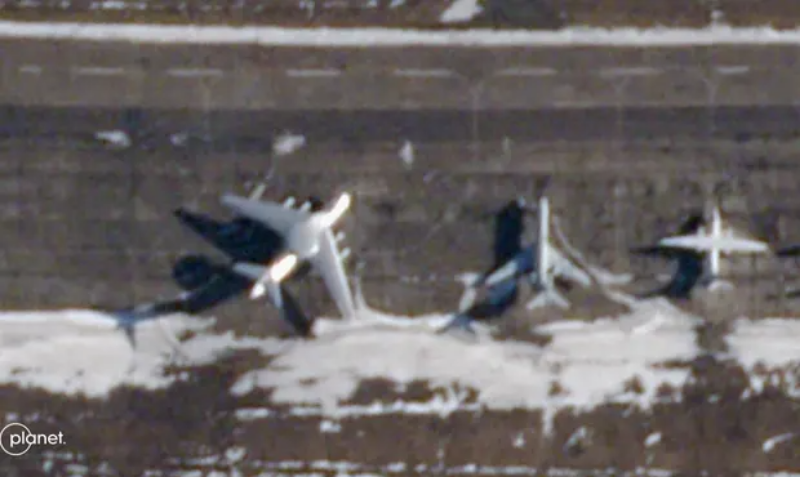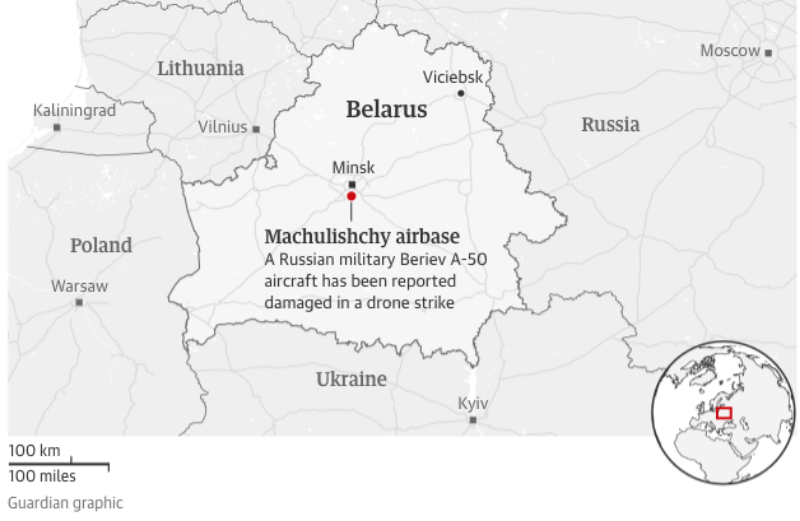Belarusian anti-war partisans claim to have severely damaged a Russian military aircraft in what an opposition leader has called the “most successful diversion” since the beginning of the war.
BYPOL, the Belarusian partisan organisation, said it had used drones to strike the Machulishchy airfield 1km from Minsk, severely damaging a Beriev A-50 airborne early warning and control aircraft (Awacs).
“One of the nine Awacs of the Russian aerospace forces worth $330M (was destroyed),” the group said. “These were drones. The participants of the operation are Belarusians. (They have attained) ‘Victory’ and are now safely outside the country. Everyone has escaped.”
The plane “definitely won’t fly anywhere”, it added.
According to some reports, the aircraft was hit by munitions dropped by two drones. A second munition reportedly hit close to the cockpit.
“The front and middle section of the aircraft were damaged, as well as avionics and a radar antenna,” said a report attributed to BYPOL.
The damage to the aircraft has not been independently confirmed, although both Russian and Belarusian military bloggers have reported explosions on Sunday at the airfield. One also confirmed “damage to a Russian military transport plane”.
“This is the most successful diversion since the beginning of 2022,” wrote Franak Viačorka, an adviser to the Belarusian opposition leader, Sviatlana Tsihanouskaya. “Two Belarusians conducted the operation. They used drones for this operation and have already left the country and are in safety now.”
According to Belarusian Hajun Project, which monitors resistance activity to Russian forces in Belarusian territory, the attack was performed with drone-dropped munitions.
An A-50, registration RF-86843, which arrived at Machulishchy air base at 18:33 local time (3:33 PM GMT) was attacked, according to the project’s website, which refers to insider sources.
The website also lists several reports from local residents who heard the explosions and noticed an immediate ramp-up in the presence of security forces around the airport.
Belarusian militia and the personnel of special purpose police detachment “OMON” began to stop cars and check the documents of residents in the Machulishchy area the same evening, messages from local Telegram chats show.
According to Belarusian Hajun, local law enforcement personnel later found a bag containing the remotes that were used to control the drones.
Official Belarusian news channels did not publish any news about the alleged attack. According to Belarusian media, an urgent meeting of high-ranking security officials was called in the morning of February 27.

A satellite image shows aircraft, including a Beriev A-50 military surveillance plane, at the Machulishchy air base outside Minsk, Belarus, February 19, 2023. Photograph: Planet Labs Pbc/Reuters
Dmitry Peskov, a Kremlin spokesperson, declined to comment on reports of the attack on Monday. “We have nothing to say about this,” he told journalists on Monday.
The Beriev A50 represents old technology, built around the air frame of an Ilyushin transport plane. While first coming into service in the mid-1980s, it is also still a key military technology.
With about 40 of the aircraft built – and nine reportedly still in active service – they are able to detect when air defence systems are activated and where, allowing Russia to target those air defences. More broadly, such so-called airborne early warning and control aircraft are used to detect aircraft, shipping, missiles, and other incoming projectiles at long ranges, surveil the battlefield and help with battlefield management.



Let’s give Ukraine the ATACMS so they can counter anything coming in from Belarus.